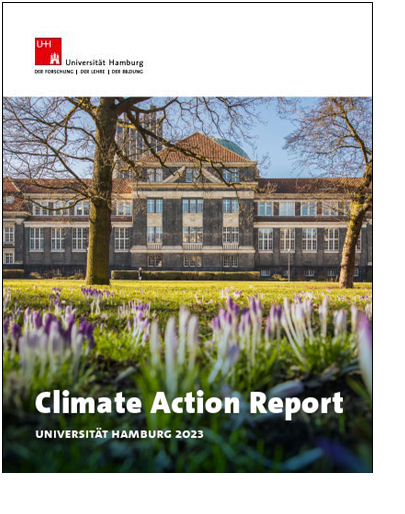Climate Protection Plan
Humanity is facing existential challenges in the area of sustainability—above all the climate crisis and species extinction. These challenges must be addressed proactively to preserve a livable planet for current and future generations. Universität Hamburg is considered a university for a sustainable future and has performed pioneering work in this area in recent years. The University wishes to continue to live up to this responsibility in the future by practicing and actively shaping sustainable action within its own 4 walls.
It wishes to fulfill its social responsibility and is thus publishing its first pan-university climate protection plan (PDF). This plan is based on the current situation and lays out the direction of the University’s planned transformation in the area of climate protection. Goals for reducing emissions will be formulated based on the status of our greenhouse gas accounting, and the transformation process will be presented in the form of a catalog of measures.
Greenhouse gas accounting standard
Climate reporting at Universität Hamburg is based on the Greenhouse Gas (GHG) Protocol standard. The GHG Protocol involves multiple stakeholders committed to developing and implementing internationally recognized standards for accounting for greenhouse gas emissions. They created the internationally recognized GHG Protocol, which can be used to account for the full range of greenhouse gas risks and opportunities associated with direct and indirect emissions. For effective greenhouse gas management, the GHG Protocol (WRI/WBCSD, 2004) divides greenhouse gas emissions into 3 areas (Scopes 1 to 3).
Defining the system boundaries
The emissions included in a university’s greenhouse gas accounting are determined by defining the organizational and operational system boundaries. With regard to the University’s participation structure, the organizational system boundary deals with the question of which University units are to be included in the accounting. In contrast, the operational system boundary defines the University activities and processes that are to be reported.
Universität Hamburg uses the operational control approach in accordance with the GHG Protocol to define the organizational system boundary. This approach includes all greenhouse gas emissions that are under Universität Hamburg’s operational control. Universität Hamburg’s greenhouse gas accounting includes the following units (excluding the University Medical Center Hamburg-Eppendorf and the Faculty of Medicine,
as they have their own business plans):
- Executive University Board
- all University Administration departments and units
- the faculties
- central institutions
- the staff councils and representatives
The operational system boundary determines which activities and processes are included in Universität Hamburg’s greenhouse gas accounting. Direct emissions from natural gas, heating oil, diesel, petrol, and refrigerants (Scope 1) as well as indirect emissions from purchased electricity and district heating (Scope 2) are mandatory for the GHG Protocol standard; upstream and downstream emissions (Scope 3) are optional. In line with Universität Hamburg’s efforts to report the greenhouse gas emissions produced by the University as completely as possible, full accounting is provided for Scopes 1 to 3. Scope 3 includes greenhouse gas emissions from the following categories:
- fuel and energy-related emissions
- supply and disposal
- upstream transport and distribution of purchased goods
- goods purchases
- rented and leased tangible assets
- mobility
Climate neutrality
Universität Hamburg’s goal is to achieve climate neutrality in the GHG Protocol Scopes 1 and 2 by 2030. Compensation should be made only if emissions cannot be avoided, which may be the case in a few areas of research. At the core of our activities should be the guiding principle to avoid before reducing and to reduce before compensating.

